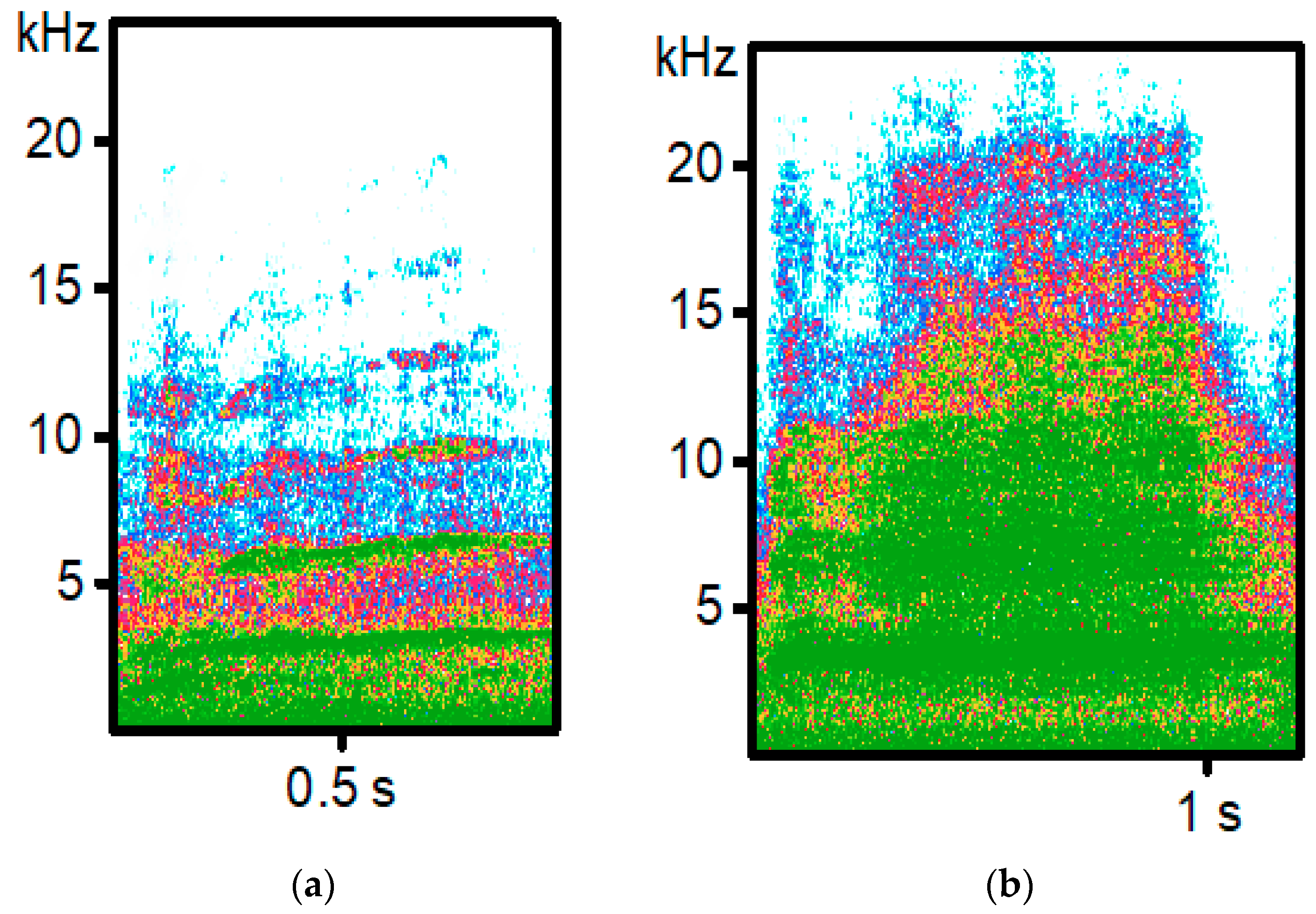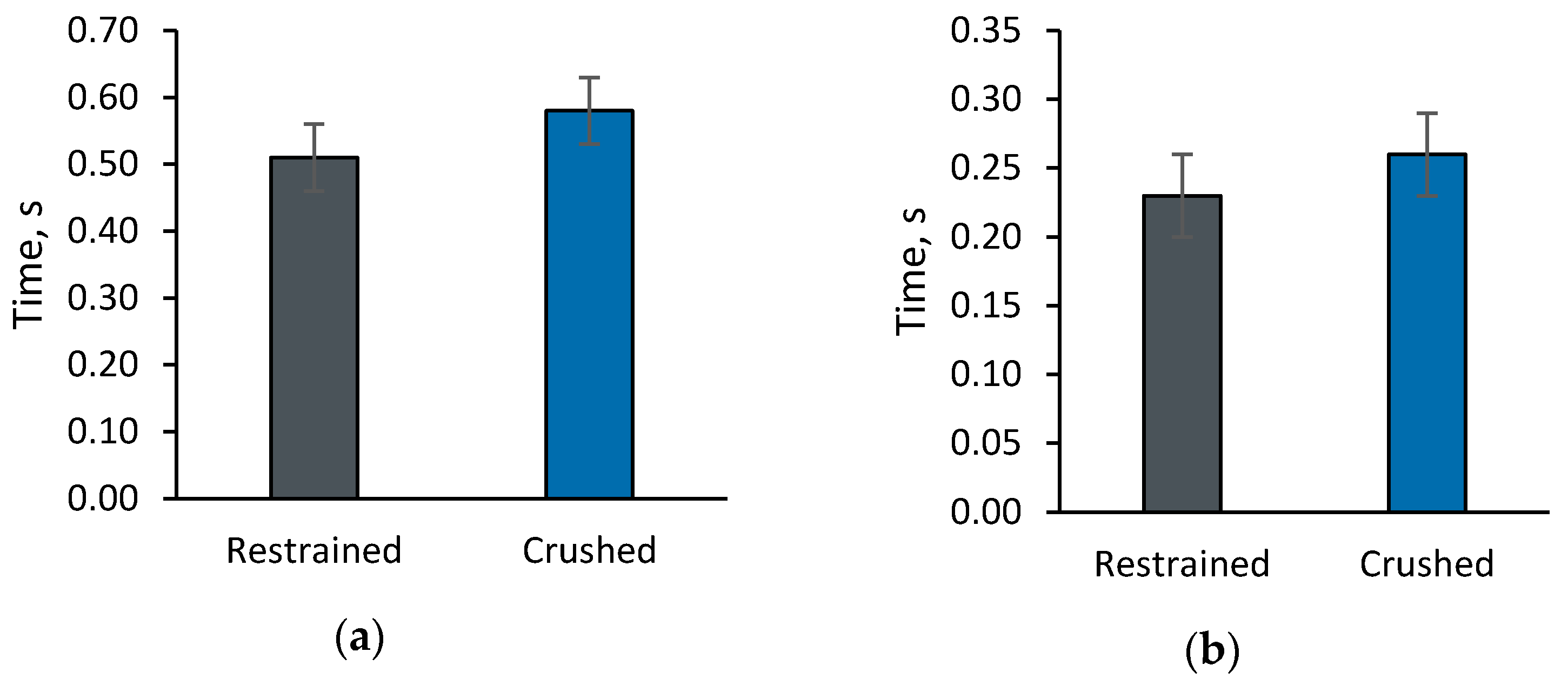Comparison of Vocalization Patterns in Piglets Which Were Crushed to Those Which Underwent Human Restraint
Abstract
:Simple Summary
Abstract
1. Introduction
2. Materials and Methods
2.1. Animals and Procedures
2.2. Statistics
3. Results
3.1. Max Parameters
3.2. Mean Parameters
4. Discussion
5. Conclusions
Author Contributions
Funding
Acknowledgments
Conflicts of Interest
References
- United States Department of Agriculture. National Animal Health Monitoring System. Swine 2012, Part 1: Baseline Reference of Swine Health and Management in the United States; USDA: Washington, DC, USA, 2012.
- Hutson, G.D.; Wilkinson, J.L.; Luxford, B.G. The response of lactating sows to tactile, visual and auditory stimuli associated with a model piglet. Appl. Anim. Behav. Sci. 1991, 32, 129–137. [Google Scholar] [CrossRef]
- Andersen, I.L.; Berg, S.; Bøe, K.E. Crushing of piglets by the mother sow (Sus scrofa)—Purely accidental or a poor mother? Appl. Anim. Behav. Sci. 2005, 93, 229–243. [Google Scholar] [CrossRef]
- Hutson, G.D.; Price, E.O.; Dickenson, L.G. The effect of playback volume and duration on the response of sows to piglet distress calls. Appl. Anim. Behav. Sci. 1993, 37, 31–37. [Google Scholar] [CrossRef]
- Illmann, G.; Hammerschmidt, K.; Špinka, M.; Tallet, C. Calling by domestic piglets during simulated crushing and isolation: A signal of need? PLoS ONE 2013, 8, e83529. [Google Scholar] [CrossRef] [PubMed]
- Puppe, B.; Schӧn, C.; Tuchscherer, A.; Manteuffel, G. Castration-induced vocalization in domestic piglets, Sus scrofa: Complex and specific alterations of the vocal quality. Appl. Anim. Behav. Sci. 2005, 92, 67–84. [Google Scholar] [CrossRef]
- Arnal, L.; Flinker, A.; Kleinschmidt, A.; Giraud, A.L.; Poeppel, D. Human screams occupy a privileged niche in the communication soundscape. Curr. Biol. 2015, 25, 2051–2056. [Google Scholar] [CrossRef] [PubMed]
- Marchant, J.N.; Broom, D.M.; Corning, S. The influence of sow behaviour on piglet mortality due to crushing in an open farrowing system. Anim. Sci. 2001, 72, 19–28. [Google Scholar] [CrossRef]
- Linhart, P.; Ratcliffe, V.F.; Reby, D.; Špinka, M. Expression of emotional arousal in two different piglet call types. PLoS ONE 2015, 10, e0135414. [Google Scholar] [CrossRef] [PubMed]
- Boesrma, P.; Weenink, D. PRAAT: Doing Phonetics by Computer. Version 5.4.15. Available online: http://www.fon.hum.uva.nl/praat/ (accessed on 14 June 2018).
- Marx, G.; Horn, T.; Thielebein, J.; Knubel, B.; von Borell, E. Analysis of pain-related vocalization in young pigs. J. Sound Vib. 2003, 266, 687–698. [Google Scholar] [CrossRef]
- Weary, D.M.; Braithwaite, L.A.; Fraser, D. Vocal response to pain in piglets. Appl. Anim. Behav. Sci. 1998, 56, 161–172. [Google Scholar] [CrossRef]
- Marchant-Forde, J.N.; Lay, D.C., Jr.; McMunn, A.; Cheng, H.W.; Pajor, E.A.; Marchant-Forde, R.M. Postnatal piglet husbandry practices and well-being: The effects of alternative techniques delivered separately. J. Anim. Sci. 2009, 87, 1479–1492. [Google Scholar] [CrossRef] [PubMed]
- Torrey, S.; Devillers, N.; Lessard, M.; Farmer, C.; Widowksi, T. Effect of age on the behavioral and physiological responses of piglets to tail docking and ear notching. J. Anim. Sci. 2009, 87, 1779–1786. [Google Scholar] [CrossRef] [PubMed]
- Garcia, M.; Wondrak, M.; Huber, L.; Fitch, W.T. Honest signaling in domestic pigs (Sus scrofa domesticus): Vocal allometry and the information content of grunt calls. J. Exp. Biol. 2016, 219, 1913–1921. [Google Scholar] [CrossRef] [PubMed]
- Remez, R.E.; Rubin, P.E.; Pisoni, D.B.; Carrell, T.D. Speech perception without traditional speech cues. Science 1981, 212, 947–950. [Google Scholar] [CrossRef] [PubMed]
- Weary, D.M.; Pajor, E.A.; Thomspon, B.K.; Fraser, D. Risky behaviour by piglets: A tradeoff between feeding and risk of mortality by maternal crushing? Anim. Behav. 1996, 51, 619–624. [Google Scholar] [CrossRef]
- Leslie, E.; Hernández-Jover, M.; Newman, R.; Holyoake, P. Assessment of acute pain experienced by piglets from ear tagging, ear notching and intraperitoneal injectable transponders. Appl. Anim. Behav. Sci. 2010, 127, 86–95. [Google Scholar] [CrossRef]


| Parameter | Description |
|---|---|
| Total Duration; s | Total time from the onset to the end of a call |
| Start to peak; s | Distance from the beginning of the call until the loudest element is reached |
| Peak Frequency; Hz | Loudest frequency found within a call |
| Peak Amplitude; dB | Measurement of the highest energy within a call |
| Minimum frequency; Hz | The lowest frequency within a call above the threshold (30 dB) |
| Maximum frequency; Hz | The highest frequency within a call above the threshold (30 dB) |
| Bandwidth; Hz | The difference between the minimum and maximum frequency |
| Fundamental frequency, Hz | Lowest frequency in a distinct harmonic structure |
| First formant, Hz | First detectable concentration of frequencies forming a band structure within a call |
| Second formant, Hz | Second detectable concentration of frequencies forming a band structure within a call |
| Quartile 25%; Hz | Frequency found at 25% of the total energy in call |
| Quartile 50%; Hz | Frequency found at 50% of the total energy in call |
| Quartile 75%; Hz | Frequency found at 75% of the total energy in call |
| Entropy | The randomness within a call where zero is a pure-tone and one is completely random noise |
| Harmonic-to-noise ratio | Ratio of the degree of harmonic sound to additional noise produced within a call |
| Parameter | Restrained (max) | Crushed (max) | p-Value | Restrained (mean) | Crushed (mean) | p-Value |
|---|---|---|---|---|---|---|
| Peak Frequency; Hz | 2953.74 ± 335.3 | 1568.27 ± 343.8 | 0.01 | 2566.12 ± 235.0 | 1497.08 ± 239.4 | 0.01 |
| Peak Amplitude; dB | 85.88 ± 1.5 | 82.14 ± 1.6 | 0.11 | 76.59 ± 1.6 | 73.83 ± 1.6 | 0.24 |
| Minimum frequency; Hz | 972.74 ± 121.6 | 358.96 ± 127.8 | 0.001 | 1130.08 ± 155.0 | 441.27 ± 158.2 | 0.006 |
| Maximum frequency; Hz | 7619.69 ± 644.8 | 5293.22 ± 656.4 | 0.02 | 5759.86 ± 426.7 | 4392.23 ± 433.3 | 0.37 |
| Bandwidth; Hz | 6674.99 ± 574.0 | 4897.01 ± 587.3 | 0.04 | 4587.47 ± 334.5 | 3904.95 ± 342.1 | 0.17 |
| Fundamental frequency, Hz | 1214.86 ± 203.2 | 523.57 ± 210.6 | 0.03 | 965.96 ± 149.6 | 619.72 ± 151.0 | 0.12 |
| First formant, Hz | 2523.07 ± 118.2 | 1989.74 ± 121.0 | 0.005 | 2281.49 ± 98.3 | 1984.69 ± 100. | 0.05 |
| Second formant, Hz | 3603.89 ± 85.5 | 3395.68± 87.9 | 0.11 | 3533.48 ± 70.6 | 3414.48 ± 72.0 | 0.25 |
| Quartile 25%; Hz | 2866.29 ± 279.0 | 1630.95 ± 285.4 | 0.006 | 2474.03 ± 196.8 | 1701.45 ± 199.7 | 0.01 |
| Quartile 50%; Hz | 3759.52 ± 322.5 | 2338.96 ± 328.4 | 0.006 | 3899.07 ± 258.9 | 2966.97 ± 262.1 | 0.02 |
| Quartile 75%; Hz | 5630.20 ± 436.1 | 3919.92 ± 442.7 | 0.01 | 5943.15 ± 362.1 | 4887.73 ± 365.8 | 0.06 |
| Entropy 1 | 0.40 ± 0.1 | 0.36 ± 0.1 | 0.35 | 0.48 ± 0.1 | 0.46 ± 0.1 | 0.69 |
| Harmonic-to-noise ratio | 16.49 ± 2.5 | 19.21 ± 2.5 | 0.46 | 18.54 ± 2.8 | 20.07 ± 2.8 | 0.71 |
© 2018 by the authors. Licensee MDPI, Basel, Switzerland. This article is an open access article distributed under the terms and conditions of the Creative Commons Attribution (CC BY) license (http://creativecommons.org/licenses/by/4.0/).
Share and Cite
Chapel, N.M.; Lucas, J.R.; Radcliffe, S.; Stewart, K.R.; Lay, D.C. Comparison of Vocalization Patterns in Piglets Which Were Crushed to Those Which Underwent Human Restraint. Animals 2018, 8, 138. https://doi.org/10.3390/ani8080138
Chapel NM, Lucas JR, Radcliffe S, Stewart KR, Lay DC. Comparison of Vocalization Patterns in Piglets Which Were Crushed to Those Which Underwent Human Restraint. Animals. 2018; 8(8):138. https://doi.org/10.3390/ani8080138
Chicago/Turabian StyleChapel, Nichole M., Jeffrey R. Lucas, Scott Radcliffe, Kara R. Stewart, and Donald C. Lay. 2018. "Comparison of Vocalization Patterns in Piglets Which Were Crushed to Those Which Underwent Human Restraint" Animals 8, no. 8: 138. https://doi.org/10.3390/ani8080138
APA StyleChapel, N. M., Lucas, J. R., Radcliffe, S., Stewart, K. R., & Lay, D. C. (2018). Comparison of Vocalization Patterns in Piglets Which Were Crushed to Those Which Underwent Human Restraint. Animals, 8(8), 138. https://doi.org/10.3390/ani8080138




